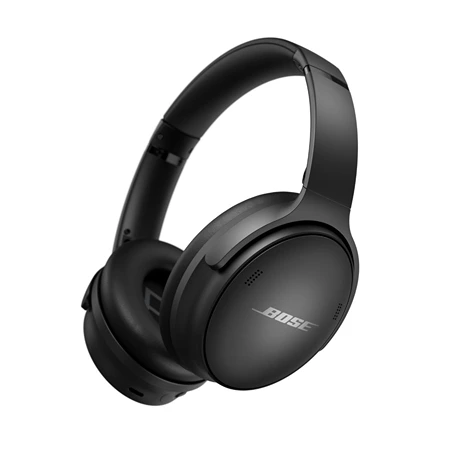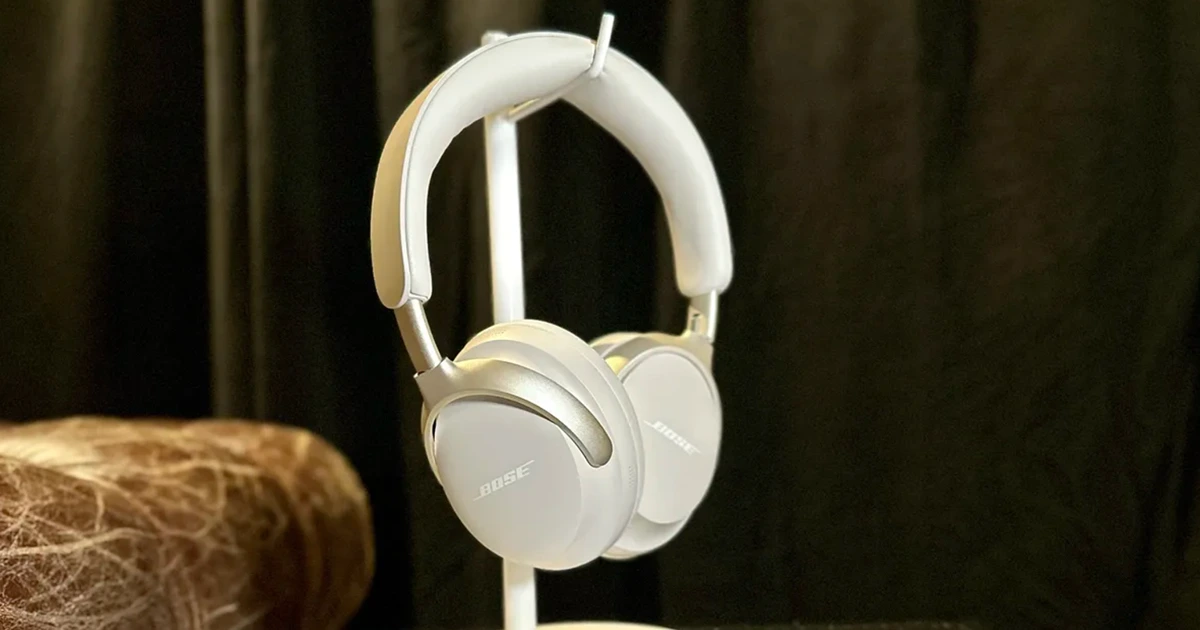
These headphones are an audio gem, delivering rich sound with bold bass, smooth highs, stellar noise cancellation, and more.
Buy on AmazonBose has introduced its latest offering in the world of audio with the QuietComfort Headphones, priced at $349. This new model steps in to replace the well-received QuietComfort 45, which retailed for $329. With this upgrade, Bose brings a refreshed sound profile to the table, emphasizing deeper, richer bass while dialing back slightly on the sculpted highs that defined its predecessor.
Much of what made the QuietComfort 45 a fan favorite remains intact. The new QuietComfort Headphones deliver reliable Bluetooth connectivity, a polished companion app, and the exceptional active noise cancellation (ANC) that Bose is renowned for. These features ensure that the headphones remain a strong contender for anyone seeking a premium listening experience without breaking the bank.
Comfort Level & Control
When it comes to design and comfort, the Bose QuietComfort Headphones feel like a familiar friend, mirroring the look and fit of their predecessor, the QuietComfort 45. Bose spices things up with fresh color options, including the striking Cypress Green and the exclusive Moonstone Blue, available only on Bose.com. These join the classic Black and White Smoke finishes. The headband and earpads stick to the tried-and-true combo of plush memory foam and vegan leather, ensuring that cozy, all-day wearability Bose fans adore. Inside, the 40mm dynamic drivers remain unchanged from the QC 45, though they’ve been treated to a new tuning tweak for a richer sound profile. True to form, Bose keeps the frequency range specs under wraps, leaving the audio experience to speak for itself.
The Bose QuietComfort Headphones roll with Bluetooth 5.1, sticking to the AAC and SBC codecs for solid, if basic, wireless performance. Unlike some competitors, they skip the Snapdragon Sound Platform, which powers up Bluetooth 5.3 and AptX Adaptive in other Bose models. For comparison, Sony’s $399.99 WH-1000XM5 headphones pull ahead with LDAC codec support, offering a hi-res audio edge on compatible devices.
On the connectivity front, Bose SimpleSync shines as a handy perk. This feature lets you pair the QuietComfort Headphones with select Bose soundbars and speakers effortlessly. Once connected, you can sync audio playback across both devices and tweak their volume levels individually—even mute them—right from the controls. Multipoint connectivity is also on the table, allowing you to juggle two devices at once, though you’ll need to flip that switch in the companion app to make it happen.
The Bose QuietComfort Headphones make on-ear controls a breeze with a smart, tactile setup. On the right earcup, a trio of buttons takes charge: the center one is your multitasking hero—tap once to play or pause, twice to skip ahead, or three times to rewind. It also juggles a slew of call functions, from conference setups to muting, too many to detail here. Flanking it are two buttons for volume tweaks. Over on the left earcup, a lone Action button toggles between Quiet (ANC) and Aware (transparency) modes by default, though you can customize the mode cycle in the app. Prefer a shortcut? Press and hold the Action button to check battery life or trigger Spotify Tap for instant playlist access. While I’d love more customization for that Action button, this intuitive layout nails the essentials effortlessly.
The Bose QuietComfort Headphones come tucked into the same zip-up, hard-shell case as the QC 45, collapsing inward for a snug fit. It’s a practical step up from the bulky, non-folding Sony WH-1000XM5 case and leagues ahead of the flimsy pouch Apple provides with the AirPods Max. Inside, a handy pocket stashes two cables: a USB-C-to-USB-A charging cord that plugs into the right earcup’s USB-C port and a 3.5mm audio cable with an inline mic—perfectly positioned near the chin for calls—that connects to the left earcup. That wired option feels especially relevant now with remote work on the rise.
Bose pegs the QuietComfort Headphones at about 24 hours of battery life per charge, a slight edge over the QC 45’s 22 hours, though your mileage may vary depending on volume. Since ANC and Aware modes are always in play, that estimate bakes in their impact. A full charge from zero takes around 2.5 hours, keeping you powered up without too much downtime.
Bose App Experience
The Bose Music app, available for both Android and iOS, sports a sleek, streamlined design that delivers just the right mix of features and controls. It’s a step up from the QC 45 experience, unlocking mode customization options that give you a bit more flexibility to tailor your listening.
The main screen greets you with a crisp image of the QuietComfort Headphones alongside their remaining battery life. Below that, you’ll find a volume slider and tidy tiles for Modes, Source, EQ, Shortcut, and Tips. A playback bar at the bottom keeps you in the loop with track and artist info for whatever’s spinning.
Diving into the Modes section, you start with Quiet (full-on ANC) and Aware (total transparency). Additional modes—like preset options you can rename, such as Focus, Home, or Outdoor—let you mix ANC and Aware levels to your liking. However, it’s not full freedom; you can’t kill one mode without maxing the other. There’s also a Wind Block feature to toggle, but it cranks ANC to the max, limiting its customization appeal. Unlike Bose’s Ultra lineup, there’s no immersive audio or spatial sound settings here, keeping things straightforward for these headphones.
The Bose Music app’s Source section keeps things simple, displaying your paired devices and offering a toggle for multipoint connectivity. In the EQ section, you get four tweakable presets—Bass Boost, Bass Reducer, Treble Boost, and Treble Reducer—plus the ability to sculpt your own sound with a three-band setup (bass, mid, treble). It’s a basic toolset, but it gets the job done and beats having no options at all.
The Shortcuts section is optional—you can turn it on or off. If it’s live, you pick between hearing the battery level or triggering Spotify Tap via the Action button. Meanwhile, the Tips section doubles as a handy user guide, breaking down Controls, Phone Calls, Modes, and Voice Assistant basics.
Tap the settings icon in the top-right corner of the main screen to handle firmware updates, set the headphones to stick with your current audio mode, adjust how much of your voice you hear during calls, or switch voice prompts on or off. It’s a clean, no-fuss way to keep your QuietComfort Headphones dialed in.
Noise Cancellation
The Bose QuietComfort Headphones carry forward the same top-tier noise cancellation that made the QC 45 a standout, with the only edge over their predecessor being the app’s customizable modes.
In testing, they tackled deep, rumbling low frequencies with finesse, reducing them to a whisper, and sliced through a broad chunk of a loud white noise recording. Some highs and mids peeked through—tough for any ANC tech to fully erase—but the performance was impressive. When pitted against a bustling restaurant recording, the headphones sharply cut the highs and mids while softening the lows. A faint high-frequency hiss crept in during some tests, but that’s par for the course with noise-canceling gear and hardly a dealbreaker.
When stacked against the Sony WH-1000XM5, the Bose QuietComfort Headphones shine brighter at taming mids and highs, though they’re neck-and-neck on low-frequency rumble. Both leave Apple’s $549 AirPods Max in the dust.
Bose’s Aware mode is a gem, letting you tune into your surroundings clearly without ditching the headphones. That said, the app doesn’t let you tweak Aware mode’s intensity without flipping on ANC, nor can you prioritize conversations. Unlike the QuietComfort Ultra, these also skip the Active Sense Aware mode, which cuts through loud ambient noise while keeping you connected—a small trade-off for their price point.
Sound Profile & Audio
The sound profile of the Bose QuietComfort Headphones marks the most significant upgrade from the QC 45. Bose representatives highlighted adjustments to the digital signal processing (DSP) to achieve “a smoother, more natural high end” while enhancing deep low-frequency response for “more punch without sounding muddy.”
Testing revealed clear distinctions between the two models using identical tracks. The QC 45 emphasizes sculpted highs, with cymbals and upper-register strings sounding bright, though not always more detailed. In contrast, the QuietComfort Headphones offer a fuller, richer tone, delivering crisp yet natural high frequencies. For those favoring a brighter signature, the in-app EQ’s treble boost can approximate the QC 45’s style.
On tracks with intense sub-bass, the QuietComfort Headphones shine, producing a robust low-end that bass enthusiasts will appreciate. The intensified lows maintain the mix’s balance, though some might prefer a less weighty approach. When handling complex sub-bass passages, the headphones excel, rendering every element with vigor. Deep notes hit with commanding power—a challenge for many competitors—while vocals remain clear and prominent, even amidst the hefty bass presence.
The Bose QuietComfort Headphones reveal their sound signature effectively on tracks with minimal deep bass. Drums maintain a natural tone, suggesting Bose avoids blanket boosts across the low-frequency spectrum. These drums sit in the woofer range rather than dipping into subwoofer depths. Baritone vocals come through with equal richness and clarity, while higher-register percussion details shine brightly, though they lack the extra edge heard in the QC 45.
On orchestral compositions, such as opening scenes with intricate instrumentation, the QuietComfort Headphones emphasize lows and midrange more than the QC 45. Both models deliver bright sound, but the newer pair brings a touch more lower-frequency weight. The presentation leans toward the new model’s style, though neither achieves strict accuracy.
The voice mic array performs reliably, capturing every word clearly in test recordings on a smartphone. However, the signal can occasionally feel fainter and less sharp compared to the clarity typical of true wireless earphones.
Final Verdict
A refined sound profile, fresh color options, and customizable ANC modes nudge the Bose QuietComfort Headphones ahead of their predecessors. However, they come with a higher price tag and lack the immersive audio features and advanced Bluetooth specs promised by the upcoming QuietComfort Ultra Headphones. For alternatives, the Sony WH-1000XM5 stands out, especially for Android users tapping into LDAC codec support. Apple enthusiasts might still gravitate toward the AirPods Max for their flawless iOS pairing. Yet, for those prioritizing top-tier noise cancellation without chasing premium codecs, the Bose QuietComfort Headphones remain a compelling, straightforward choice.
